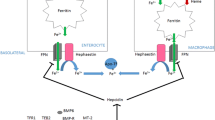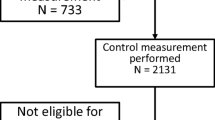Abstract
Hereditary hemochromatosis is an iron overload disorder and is the most common recessive disease in Caucasians. About 80% of hemochromatosis patients are homozygous for the C282Y mutation in the HFE gene. Since iron accumulation can be prevented by phlebotomy, there is increasing interest in screening populations for hemochromatosis. Hemochromatosis is a disease that meets all the criteria for screening as set by the World Health Organization (WHO) or the US preventive services task force criteria for a screening program. However, there is no consensus on the value of a screening program for hemochromatosis. Moreover, there is no agreement on whether this screening should be based on the phenotype i.e. biochemical levels of serum iron parameters or on the genotype i.e. based on the presence of mutations in the HFE gene. Other important concerns are the lack of important data in evaluating screening as well as the psychosocial impact of a screening program. The present review analyses the current situation from a genetic-epidemiological perspective. We conclude that general population screening may be helpful to identify high-risk groups or individuals in the early stage of the disease so that treatment can be started. We suggest a two-phase screening program based on the first instance on serum iron levels and then a genetic test to only those with elevated serum iron parameters.
Similar content being viewed by others
References
Adams P, Brissot P, Powell LW. EASL International Consensus Conference on Haemochromatosis. J Hepatol 2000; 33: 485–504.
Powell LW, Leggett BA, Crawford DHG. Hemochromatosis and other iron storage disorders. In: Schiff ER, Sorrel MF, Maddrey WC (eds), Schiff's diseases of the liver. Philadelphia: Lippincott-Raven, 1999: 1107–1130.
Edwards CQ, Griffen LM, Goldgar D, Drummond C, Skolnick MH, Kushner JP. Prevalence of hemochromatosis among 11,065 presumably healthy blood donors. N Engl J Med 1988; 318: 1355–1362.
Leggett BA, Halliday JW, Brown NN, Bryant S, Powell LW. Prevalence of haemochromatosis amongst asymptomatic Australians. Br J Haematol 1990; 74: 525–530.
Baer DM, Simons JL, Staples RL, Rumore GJ, Morton CJ. Hemochromatosis screening in asymptomatic ambulatory men 30 years of age and older. Am J Med 1995; 98: 464–468.
Cardoso EM, Stal P, Hagen K, et al. HFE mutations in patients with hereditary haemochromatosis in Sweden. J Intern Med 1998; 243: 203–208.
Powell L, Jazwinska E, Halliday J. Primary iron overload. In: Brock J, Halliday J, Pippard M, Powell L (eds), Iron metabolism in health and disease. London: Saunders, 1994: 227–270.
Witte DL, Crosby WH, Edwards CQ, Fairbanks VF, Mitros FA. Practice guideline development task force of the College of American Pathologists. Hereditary hemochromatosis. Clin Chim Acta 1996; 245: 139–200.
Finch S, Finch C. Idiopathic hemochromatosis, an iron storage disease. A: Iron metabolism in hemochromatosis. Medicine 1955; 34: 381–430.
Scheuer P, Williams R, Muir A. Hepatic pathology in relatives of patients with hemochromatosis. J Pathol Bacteriol 1962; 84: 53–64.
Bassett ML, Halliday JW, Powell LW. Value of hepatic iron measurements in early hemochromatosis and determination of the critical iron level associated with fibrosis. Hepatology 1986; 6: 24–29.
Feder JN, Gnirke A, Thomas W, et al. A novel MHC class I-like gene is mutated in patients with hereditary haemochromatosis. Nat Genet 1996; 13: 399–408.
Powell LW. Diagnosis of hemochromatosis. Semin Gastrointest Dis 2002; 13: 80–88.
Sheldon J. Hemochromatosis. London: Oxford University Press; 1935.
Saddi R, Feingold J. Hemochromatose idiopathique. Maladie recessive autosomique. Rev Fr Etud Clin Biol 1969; 14: 238–251.
Saddi R, Feingold J. Idiopathic haemochromatosis: An autosomal recessive disease. Clin Genet 1974; 5: 234–241.
Simon M, Alexandre JL, Bourel M, Le Marec B, Scordia C. Heredity of idiopathic haemochromatosis: A study of 106 families. Clin Genet 1977; 11: 327–341.
Simon M, Hespel JP, Fauchet R, et al. Heredite recessive de l'hemochromatose idiopathique: deux observations de transmission pseudo-dominante reconnue comme recessive par l'etude de la surcharge en fer et des genotypes HLA dans les familles. Nouv Presse Med 1979; 8: 421–424.
Simon M, Alexandre JL, Fauchet R, Genetet B, Bourel M. The genetics of hemochromatosis. Prog Med Genet 1980; 4: 135–168.
Barton JC, Shih WW, Sawada-Hirai R, et al. Genetic and clinical description of hemochromatosis probands and heterozygotes: Evidence that multiple genes linked to the major histocompatibility complex are responsible for hemochromatosis. Blood Cells Mol Dis 1997; 23: 135–145.
Brissot P, Moirand R, Jouanolle AM, et al. A genotypic study of 217 unrelated probands diagnosed as 'genetic hemochromatosis' on 'classical' phenotypic criteria. J Hepatol 1999; 30: 588–593.
Moirand R, Jouanolle AM, Brissot P, Le Gall JY, David V, Deugnier Y. Phenotypic expression of HFE mutations: A French study of 1110 unrelated ironoverloaded patients and relatives. Gastroenterology 1999; 116: 372–377.
Whitfield JB, Cullen LM, Jazwinska EC, et al. Effects of HFE C282Y and H63D polymorphisms and polygenic background on iron stores in a large community sample of twins. Am J Hum Genet 2000; 66: 1246–1258.
Beutler E, Gelbart T, West C, et al. Mutation analysis in hereditary hemochromatosis. Blood Cells Mol Dis 1996; 22: 187–194.
Borot N, Roth M, Malfroy L, et al. Mutations in the MHC class I-like candidate gene for hemochromatosis in French patients. Immunogenetics 1997; 45: 320–324.
Jazwinska EC, Powell LW. Hemochromatosis and 'HLA-H': Definite! Hepatology 1997; 25: 495–496.
Pointon JJ, Wallace D, Merryweather-Clarke AT, Robson KJ. Uncommon mutations and polymorphisms in the hemochromatosis gene. Genet Test 2000; 4: 151–161.
Parkkila S, Waheed A, Britton RS, et al. Immunohistochemistry of HLA-H, the protein defective in patients with hereditary hemochromatosis, reveals unique pattern of expression in gastrointestinal tract. Proc Natl Acad Sci USA 1997; 94: 2534–2539.
Lebron JA, Bennett MJ, Vaughn DE, et al. Crystal structure of the hemochromatosis protein HFE and characterization of its interaction with transferrin receptor. Cell 1998; 93: 111–123.
Merryweather-Clarke AT, Pointon JJ, Shearman JD, Robson KJ. Global prevalence of putative haemochromatosis mutations. J Med Genet 1997; 34: 275–278.
Hanson EH, Imperatore G, Burke W. HFE gene and hereditary hemochromatosis: A HuGE review. Human Genome Epidemiology. Am J Epidemiol 2001; 154: 193–206.
Jouanolle AM, Gandon G, Jezequel P, et al. Haemochromatosis and HLA-H. Nat Genet 1996; 14: 251–252.
Cazzola M, Ascari E, Barosi G, et al. Juvenile idiopathic haemochromatosis: A life-threatening disorder presenting as hypogonadotropic hypogonadism. Hum Genet 1983; 65: 149–154.
Camaschella C, Roetto A, Cicilano M, et al. Juvenile and adult hemochromatosis are distinct genetic disorders. Eur J Hum Genet 1997; 5: 371–375.
Charlton RW, Abrahams C, Bothwell TH. Idiopathic hemochromatosis in young subjects. Clinical, pathological, and chemical findings in four patients. Arch Pathol 1967; 83: 132–140.
Cazzola M, Cerani P, Rovati A, Iannone A, Claudiani G, Bergamaschi G. Juvenile genetic hemochromatosis is clinically and genetically distinct from the classical HLA-related disorder. Blood 1998; 92: 2979–2981.
Kelly AL, Rhodes DA, Roland JM, Schofield P, Cox TM. Hereditary juvenile haemochromatosis: A genetically heterogeneous life-threatening iron-storage disease. QJM 1998; 91: 607–618.
Roetto A, Totaro A, Cazzola M, et al. Juvenile hemochromatosis locus maps to chromosome 1q. Am J Hum Genet 1999; 64: 1388–1393.
Papanikolaou G, Papaioannou M, Politou M, et al. Genetic heterogeneity underlies juvenile hemochromatosis phenotype: Analysis of three families of northern greek origin. Blood Cells Mol Dis 2002; 29: 168–173.
Camaschella C, Roetto A, Cali A, et al. The gene TFR2 is mutated in a new type of haemochromatosis mapping to 7q22. Nat Genet 2000; 25: 14–15.
Roetto A, Daraio F, Alberti F, et al. Hemochromatosis due to mutations in transferrin receptor 2. Blood Cells Mol Dis 2002; 29: 465–470.
Pietrangelo A, Montosi G, Totaro A, et al. Hereditary hemochromatosis in adults without pathogenic mutations in the hemochromatosis gene. N Engl J Med 1999; 341: 725–732.
Montosi G, Donovan A, Totaro A, et al. Autosomaldominant hemochromatosis is associated with a mutation in the ferroportin (SLC11A3) gene. J Clin Invest 2001; 108: 619–623.
Njajou OT, Vaessen N, Joosse M, et al. A mutation in SLC11A3 is associated with autosomal dominant hemochromatosis. Nat Genet 2001; 28: 213–214.
Devalia V, Carter K, Walker AP, et al. Autosomal dominant reticuloendothelial iron overload associated with a 3-base pair deletion in the ferroportin 1 gene (SLC11A3). Blood 2002; 100: 695–697.
Roetto A, Merryweather-Clarke AT, Daraio F, et al. A valine deletion of ferroportin 1: A common mutation in hemochromastosis type 4. Blood 2002; 100: 733–734.
Wallace DF, Pedersen P, Dixon JL, et al. Novel mutation in ferroportin1 is associated with autosomal dominant hemochromatosis. Blood 2002; 100: 692–694.
Townsend A, Drakesmith H. Role of HFE in iron metabolism, hereditary haemochromatosis, anaemia of chronic disease, and secondary iron overload. Lancet 2002; 359: 786–790.
Kato J, Fujikawa K, Kanda M, et al. A mutation, in the iron-responsive element of H ferritin mRNA, causing autosomal dominant iron overload. Am J Hum Genet 2001; 69: 191–197.
Baer D. Hereditary iron overload and African Americans. Am J Med 1996; 101: 5–8.
Gangaidzo IT, Moyo VM, Saungweme T, et al. Iron overload in urban Africans in the 1990s. Gut 1999; 45: 278–283.
Beutler E, Gelbart T. HLA-H mutations in the Ashkenazi Jewish population. Blood Cells Mol Dis 1997; 23: 95–98.
Burke W, Thomson E, Khoury MJ, et al. Hereditary hemochromatosis: Gene discovery and its implications for population-based screening. JAMA 1998; 280: 172–178.
Edwards CQ, Kushner JP. Screening for hemochromatosis. N Engl J Med 1993; 328: 1616–1620.
Haddow JE, Ledue TB. Preventing manifestations of hereditary haemochromatosis through population based screening. J Med Screen 1994; 1: 16–21.
Bradley LA, Haddow JE, Palomaki GE. Population screening for haemochromatosis: A unifying analysis of 107 published intervention trials. J Med Screen 1996; 3: 178–184.
Wilson J, Junger G. The principle and practise of screening for disease. Public Health Papers WHO 1968; 34: 26–29.
US preventive services task force. Guide to Clinical Preventive Services: Report of the US Preventive Services Task Force. 2nd edn. Baltimore, MD, 1969, pp. 231–246.
Adams PC, Gregor JC, Kertesz AE, Valberg LS. Screening blood donors for hereditary hemochromatosis: Decision analysis model based on a 30-year database. Gastroenterology 1995; 109: 177–188.
Tavill A. Screening for hemochromatosis: Phenotyping or genotyping or both→Am J Gastroenterol 1999; 94: 1430–1433.
Beutler E, Felitti VJ, Koziol JA, Ho NJ, Gelbart T. Penetrance of 845G→A (C282Y) HFE hereditary haemochromatosis mutation in the USA. Lancet 2002; 359: 211–218.
Burt MJ, George PM, Upton JD, et al. The significance of haemochromatosis gene mutations in the general population: Implications for screening. Gut 1998; 43: 830–836.
Adams P, Valberg L. Screening blood donors fot hereditery hemochromatosis: Decision analysis model comparing genotyping to phenotyping. Am J Gastroenteroly 1999; 94: 1593–1600.
Phatak PD, Guzman G, Woll JE, Robeson A, Phelps CE. Cost-effectiveness of screening for hereditary hemochromatosis. Arch Intern Med. 1994; 11(154): 769–776; Allen K, Warner B, Delatyecki M. Clinical hemochromatosis in HFE mutation carriers. Lancet 2002; 360: 412–413.
Khoury MJ. Human genome epidemiology: Translating advances in human genetics into population-based data for medicine and public health. Genet Med 1999; 1: 71–73.
Holtzman NA, Marteau TM. Will genetics revolutionize medicine? N Engl J Med 2000; 343: 141–144.
Njajou OT, Houwing-Duistermaat JJ, Osborne R, et al. A population-based study of the effect of the HFE C282Y and H63D mutations on iron metabolism. Eur J Hum Gen 2003; 11: 225–231.
Vogelstein B, Kinzler KW. The genetic basis of human cancer. New York: McGraw-Hill, 1998.
Bassett ML, Wilson SR, Cavanaugh JA. Penetrance of HFE-related hemochromatosis in perspective. Hepatology 2002; 36: 500–503.
Cox T, Rochette J, Camaschella C, Walker A, K R. Clinical hemochromatosis in HFE mutation carriers. Lancet 2002; 360: 412.
Poullis A, Moodie SJ, Maxwell JD. Clinical hemochromatosis in HFE mutation carriers. The Lancet 2002; 360: 411.
Njajou OT, Hollander M, Koudstaal PJ, et al. Mutations in HFE gene and stroke. Stroke 2002; 33: 2363–2366.
Njajou OT, Alizadeh BZ, Vaessen N, et al. The role of hemochromatosis C282Y and H63D mutations in type 2 diabetes. Diabetes Care 2002; 25: 2112–2113.
Author information
Authors and Affiliations
Corresponding author
Rights and permissions
About this article
Cite this article
Njajou, O.T., Alizadeh, B.Z. & van Duijn, C.M. Is genetic screening for hemochromatosis worthwhile?. Eur J Epidemiol 19, 101–108 (2004). https://doi.org/10.1023/B:EJEP.0000017664.96394.b9
Issue Date:
DOI: https://doi.org/10.1023/B:EJEP.0000017664.96394.b9




